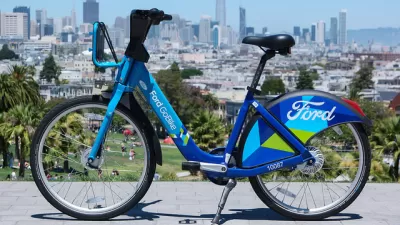Chariot shuttle service, recently acquired by Ford Motor Company, may soon be a more formidable competitor for San Francisco's public transit provider, Muni, due to an expansion to 150 vans. Expect new routes, five-minute headways, and $4 rides.
"The commuter shuttle service, recently acquired by Ford Motor Co., is adding 50 new vans to its fleet, bringing its total to 150, and hiring 75 additional drivers," reports Carolyn Said for the San Francisco Chronicle.
This will allow us to address a lot of the pent-up demand for our services, and bring in people who’ve been driving cars or taking ride-sharing,” said Ali Vahabzadeh, Chariot CEO and founder.
In addition to adding routes, "(t)he additions will nudge Chariot’s frequency to every four or five minutes during peak commute hours...," adds Said.
"The 2-year-old company, backed by $3 million in venture capital, gives thousands of rides a day at an average fare of $4, Vahabzadeh said," reported Said and David R. Baker in September, when Ford announced its acquisition of Chariot and collaboration with Motivate, the bike sharing company, to expand and rename Bay Area Bike Share.
About a fifth of riders use Chariot to complement public transit, going to or from BART, Caltrain or ferries, for instance. While it’s experienced healthy growth, the Ford deal will vault it to a new level, Vahabzadeh said.
Crowdsourcing and Crowdfunding
According to its website, Chariot "crowdsource(s) future routes and pickup/dropoff stops by learning home and work address from users like you."
Then, upon reaching a critical mass in a neighborhood, we ask you and your neighbors to crowdfund the new route’s launch by reserving your first Chariot pass. When we reach the target number of riders, Chariot launches the new route within days.
Withstood competition from other commute startups
Chariot's expansion speaks well for the service, considering that it has outlasted three other private, for-profit transit operations that served the public, assuming you had a smart phone and a credit card. Loup, Leap and Nightschool were unable to survive.
Chariot's 15-passenger shuttle vans, all Ford Transit Wagons, are not be confused with the much larger and controversial 'tech shuttles,' aka Google Buses, that are seen as disruptive to neighborhoods and, rightly or wrongly, have been associated with displacement. While they perform a regional transit function, they do not serve the public, as they shuttle tech company employees from their San Francisco homes to their Silicon Valley workplaces.
Competition for Muni?
Chariot has the potential to siphon off more riders from San Francisco Muni buses, light rail, streetcars, and cable cars (well, maybe not the latter). But could that be good for Muni?
Some experts say commuter services like Chariot could ease budget strains if they reduce the amount of public transit needed. “We’re much better off having the private sector involved (in commuter transportation) because public transit services require so much subsidizing,” said Daniel Chatman, a UC Berkeley city planning professor who studies transit. “Not too many public transit systems make a profit or even pay for themselves.”
Financially, the spread between private and public transit rides appears to be narrowing. Said writes that Chariot hopes to get "the cost closer to $3 per ride." On January 1, farebox tickets on Muni increase by a quarter to $2.50 a ride, though Clipper fares remain at $2.25.
Expansion beyond San Francisco
Chariot will be expanding to serve the Austin, Texas market, reported Greg Gardner of the Detroit Free Press in October.
Austin is an interesting market for newer ride-hailing companies because the two largest players, Uber and Lyft, withdrew after the city passed an ordinance requiring ride-hailing companies to fingerprint drivers and conduct criminal background checks [and voters rejected a referendum to reverse the ordinance].
Ford has said Chariot will be serving at least five cities by late 2017.
Hat tip to Metropolitan Transportation Commission, News Headlines.
FULL STORY: Chariot to add 50 vans, increase shuttle frequency, add routes

Alabama: Trump Terminates Settlements for Black Communities Harmed By Raw Sewage
Trump deemed the landmark civil rights agreement “illegal DEI and environmental justice policy.”

Planetizen Federal Action Tracker
A weekly monitor of how Trump’s orders and actions are impacting planners and planning in America.

Why Should We Subsidize Public Transportation?
Many public transit agencies face financial stress due to rising costs, declining fare revenue, and declining subsidies. Transit advocates must provide a strong business case for increasing public transit funding.

Understanding Road Diets
An explainer from Momentum highlights the advantages of reducing vehicle lanes in favor of more bike, transit, and pedestrian infrastructure.

New California Law Regulates Warehouse Pollution
A new law tightens building and emissions regulations for large distribution warehouses to mitigate air pollution and traffic in surrounding communities.

Phoenix Announces Opening Date for Light Rail Extension
The South Central extension will connect South Phoenix to downtown and other major hubs starting on June 7.
Urban Design for Planners 1: Software Tools
This six-course series explores essential urban design concepts using open source software and equips planners with the tools they need to participate fully in the urban design process.
Planning for Universal Design
Learn the tools for implementing Universal Design in planning regulations.
Caltrans
Smith Gee Studio
Institute for Housing and Urban Development Studies (IHS)
City of Grandview
Harvard GSD Executive Education
Toledo-Lucas County Plan Commissions
Salt Lake City
NYU Wagner Graduate School of Public Service



























